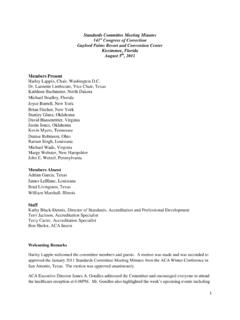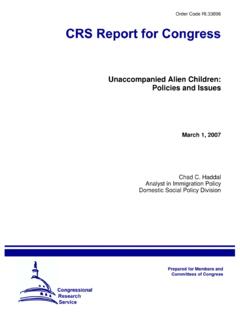Transcription of HOUSE OF REPRESENTATIVES STAFF ANALYSIS BILL #: CS/HB …
1 HOUSE OF REPRESENTATIVES STAFF ANALYSIS . BILL #: CS/HB 367 Restraint of Incarcerated Pregnant Women SPONSOR(S): Criminal Justice Subcommittee; Reed and others TIED BILLS: None BILLS: SB 524. REFERENCE ACTION ANALYST STAFF DIRECTOR or BUDGET/POLICY CHIEF. 1) Criminal Justice Subcommittee 13 Y, 0 N, As CS Krol Cunningham 2) Rulemaking & Regulation Subcommittee 15 Y, 0 N Rubottom Rubottom 3) Justice Appropriations Subcommittee 14 Y, 0 N Toms Jones Darity 4) Judiciary Committee SUMMARY ANALYSIS . The bill prohibits the use of restraints on a prisoner who is known to be pregnant during labor, delivery, and postpartum recovery unless the corrections official makes an individualized determination that the prisoner presents an extraordinary circumstance.
2 The bill specifies that even if there are extraordinary circumstances: (1) The corrections officer, correctional institution employee, or other officer accompanying the pregnant prisoner must remove all restraints if removal is requested by the treating doctor, nurse, or other health care professional; and (2) The use of leg, ankle, and waist restraints is completely prohibited during labor and delivery. The bill requires a corrections official to make written findings within 10 days after the use of restraints as to extraordinary circumstances that dictated the use of restraints.
3 The correctional institution must maintain this documentation on file and make it available for public inspection for at least 5 years. The bill also establishes additional requirements regarding restraint of pregnant prisoners during the last trimester of pregnancy. These additional requirements can also apply at any time during pregnancy if requested by the treating doctor, nurse, or other health care professional. The bill allows a prisoner who is restrained in violation of this section to file a grievance with the correctional institution within one year after the incident.
4 The bill authorizes the Department of Corrections (DOC) and the Department of Juvenile Justice (DJJ) to adopt rules to administer the new law. There is an unknown fiscal associated with an unquantified workload increase. See FISCAL SECTION . The bill is effective July 1, 2012. This document does not reflect the intent or official position of the bill sponsor or HOUSE of REPRESENTATIVES . STORAGE NAME: DATE: 2/14/2012. FULL ANALYSIS . I. SUBSTANTIVE ANALYSIS . A. EFFECT OF PROPOSED CHANGES: Background On October 10, 2010, the National Commission on Correctional Health Care Board of Directors adopted the following Position Statement on Restraint of Pregnant Inmates: Restraint is potentially harmful to the expectant mother and fetus, especially in the third trimester as well as during labor and delivery.
5 Restraint of pregnant inmates during labor and delivery should not be used. The application of restraints during all other pre-and postpartum periods should be restricted as much as possible and, when used, done so with consultation from medical STAFF . For the most successful outcome of a pregnancy, cooperation among custody STAFF , medical STAFF , and the patient is Federal Policies In October 2008, the Federal Bureau of Prisons revised its policy regarding the shackling of pregnant women in their The policy states.
6 Restraints should not be used when compelling medical reasons dictate, including when a pregnant prisoner is in labor, is delivering her baby, or is in immediate post-delivery recuperation If a pregnant prisoner is restrained, the restraints used must be the least restrictive necessary to ensure safety and security. Any restraints used must not physically constrict the direct area of the In addition to this policy, Section 232 of the Second Chance Act requires the Attorney General to report to Congress on the use of physical restraints on pregnant prisoners by agencies within the Department of Justice (DOJ).
7 4 As an agency within DOJ, the Bureau of Prisons is required to report data regarding the use of restraints to the Attorney General. Immigration and Customs Enforcement (ICE) allows restraints to be used on pregnant detainees. Specifically, ICE standards require medical STAFF to determine precautions required to protect the fetus, including: Safest method of restraint, Presence of a medical professional, and Medical necessity of restraining the detainee. 5. The Second Chance Act also requires ICE to report on its use of restraints to the Department of 1.
8 Position Paper on Restraint of Pregnant Inmates, adopted by the National Commission on Correctional Health Care Board of Directors (October 10, 2010), (last visited January 11, 2012). 2. Escorted Trips, Program Statement. Fed. Bureau of Prisons, No. , 2008. (last visited January 11, 2012). 3. Id. 4. The Second Chance Act, Pub. L. No. 110-199, 122 Stat. 657. 2008. (requiring agencies to report on the use of restraints during pregnancy, labor, delivery of a child, or post-delivery recuperation and the reasons for the use of the physical restraints, the length of time that the physical restraints were used, and the security concerns that justified the use of the physical restraints ).
9 5. ICE/DRO detention Standard, Use of Force and Restraints. , standards/ (last visited January 11, 2012). 6. Supra, the Second Chance Act. STORAGE NAME: PAGE: 2. DATE: 2/14/2012. Other States' Laws According to a 2010 study, 10 states7 have laws prohibiting the use of restraints on pregnant The Department of Juvenile Justice The Department of Juvenile Justice, through administrative rule, currently limits the use of mechanical restraints on pregnant youth: If handcuffs are used on pregnant youth, they shall be cuffed in front.
10 Leg restraints, waist chains, and the restraint belt shall not be used on pregnant youth. 9. While this rule does not address the removal of restraints during labor and delivery, current practice is to remove the restraints during labor and delivery and any time a health care professional treating the youth requests the County and Municipal Jails The Florida Model Jail Standards contain the following provision related to the shackling of inmates: Shackles or other personal restraints may be used within the secured areas of the facility.












